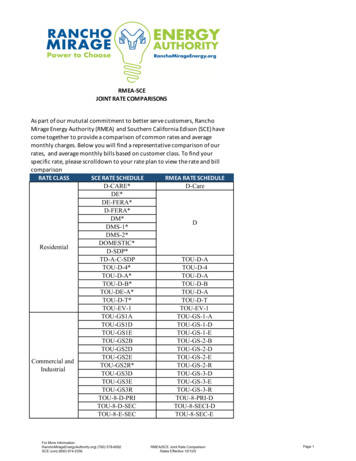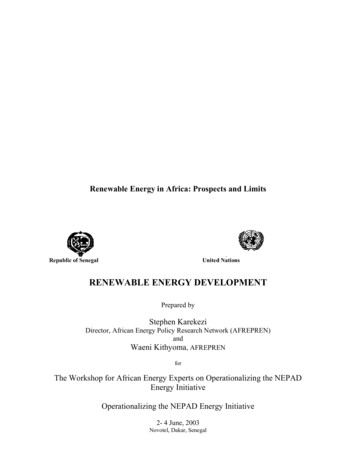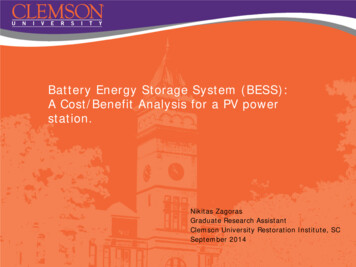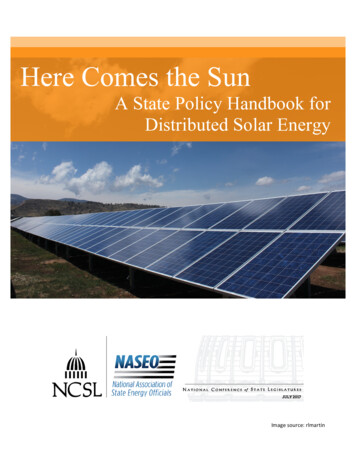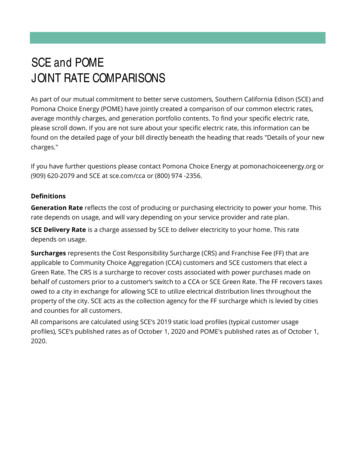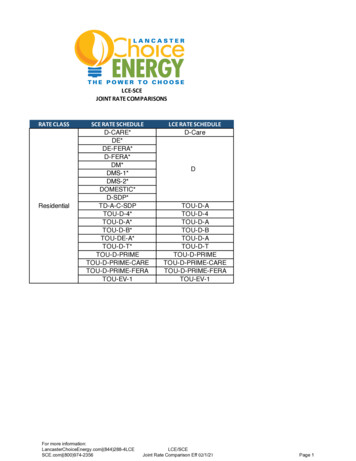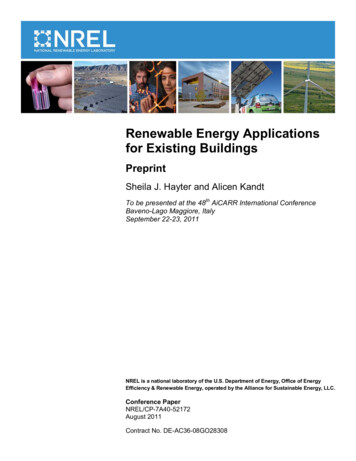
Transcription
Renewable Energy Applicationsfor Existing BuildingsPreprintSheila J. Hayter and Alicen KandtTo be presented at the 48th AiCARR International ConferenceBaveno-Lago Maggiore, ItalySeptember 22-23, 2011NREL is a national laboratory of the U.S. Department of Energy, Office of EnergyEfficiency & Renewable Energy, operated by the Alliance for Sustainable Energy, LLC.Conference PaperNREL/CP-7A40-52172August 2011Contract No. DE-AC36-08GO28308
NOTICEThe submitted manuscript has been offered by an employee of the Alliance for Sustainable Energy, LLC(Alliance), a contractor of the US Government under Contract No. DE-AC36-08GO28308. Accordingly, the USGovernment and Alliance retain a nonexclusive royalty-free license to publish or reproduce the published form ofthis contribution, or allow others to do so, for US Government purposes.This report was prepared as an account of work sponsored by an agency of the United States government.Neither the United States government nor any agency thereof, nor any of their employees, makes any warranty,express or implied, or assumes any legal liability or responsibility for the accuracy, completeness, or usefulness ofany information, apparatus, product, or process disclosed, or represents that its use would not infringe privatelyowned rights. Reference herein to any specific commercial product, process, or service by trade name,trademark, manufacturer, or otherwise does not necessarily constitute or imply its endorsement, recommendation,or favoring by the United States government or any agency thereof. The views and opinions of authorsexpressed herein do not necessarily state or reflect those of the United States government or any agency thereof.Available electronically at http://www.osti.gov/bridgeAvailable for a processing fee to U.S. Department of Energyand its contractors, in paper, from:U.S. Department of EnergyOffice of Scientific and Technical InformationP.O. Box 62Oak Ridge, TN 37831-0062phone: 865.576.8401fax: 865.576.5728email: mailto:reports@adonis.osti.govAvailable for sale to the public, in paper, from:U.S. Department of CommerceNational Technical Information Service5285 Port Royal RoadSpringfield, VA 22161phone: 800.553.6847fax: 703.605.6900email: orders@ntis.fedworld.govonline ordering: http://www.ntis.gov/help/ordermethods.aspxCover Photos: (left to right) PIX 16416, PIX 17423, PIX 16560, PIX 17613, PIX 17436, PIX 17721Printed on paper containing at least 50% wastepaper, including 10% post consumer waste.
Renewable Energy Applications for ExistingBuildingsApplicazioni dell’energia rinnovabile su edifici esistentiSHEILA J. HAYTER, PE, FASHRAE – ALICEN KANDTU.S. Department of Energy’s National Renewable Energy Laboratory – Integrated Applications CenterSUMMARYThis paper introduces technical opportunities, means, and methods for incorporating renewableenergy technologies into building designs and operations. This paper provides an overview of renewableenergy resources and available technologies used successfully to offset building electrical and thermalenergy loads. Methods for applying these technologies in buildings and the role of building energyefficiency in successful renewable energy projects are addressed. Tips on implementing effectiverenewable energy projects are also provided.RIASSUNTOQuesta memoria considera le opportunità tecniche, i mezzi e i metodi per incorporare le tecnologiead energia rinnovabile (RE) nei progetti e nel uso degli edifici. La memoria fornisce una panoramica dellerisorse RE e delle tecnologie disponibile utilizzate con successo per ridurre i carichi elettrici e termici degliedifici. Vengono considerati anche metodi per applicare queste tecnologie negli edifici ed il ruolodell’efficienza energetica nell’edificio per progetti RE riusciti. La memoria offre anche suggerimenti perimplementare progetti RE ben riusciti.1.INTRODUCTIONBuildings account for approximately 40% of the worldwide annual energy consumption (WBCSD2009). Total global energy consumption in 2007 was 495 quadrillion British thermal units (Btu), meaningthe buildings sector consumed about 198 quadrillion Btu. According to the Energy Information Agency,worldwide energy consumption is expected to increase 1.4% per year through 2035, implying thatbuildings will consume 296 quadrillion Btu by the year 2035 (EIA 2010).Fossil fuels meet a majority of world energy needs and because buildings are a large energyconsumer, they are also a major contributor to global carbon emissions and greenhouse gas (GHG)production. It is now largely recognized that addressing energy use in buildings can reduce total fossil fuelconsumption and associated GHG emissions. Benefits such as decreased building operational energy costshave prompted growing interest among policy makers, the technical community, and the general public inaddressing building energy issues and investigating solutions for decreasing building energy consumption.While energy efficiency is being incorporated into new construction, existing buildings accountfor a majority of the building stock that will be in place in the foreseeable future. In his 2009 presidentialaddress, American Society of Heating, Refrigerating, and Air-Conditioning Engineers (ASHRAE)presidential member Gordon Holness stated that 75% to 80% of the buildings that will exist in 2030 alreadyexist today (ASHRAE 2010). This statistic suggests that there is an opportunity for reducing the buildingsector’s contribution toward global energy consumption through reduction of energy use in existingbuildings.Reducing existing building energy consumption consists of two synergistic approaches: (1) toreduce the need for energy through implementation of energy efficiency measures and (2) to offset theremaining building energy needs through use of renewable energy systems (Figure 1). It is important tonote that building energy efficiency measures should be considered first, as the cost to invest in efficiencymeasures is approximately half the cost of installing renewable energy generating capacity equal to what1
the efficiency measures offset (IEA 2006). It is advised that all energy efficiency opportunities are exploredand as many are implemented as is feasible before or in conjunction with renewable energy projects forexisting buildings. It should be noted that this paper focuses only on the opportunities and issuessurrounding implementing renewable energy projects for existing buildings.Figure 1. Demonstration of how combining energy efficiency andrenewable energy strategies significantly reduce total building conventional energy use.Source: National Renewable Energy LaboratoryNational and local policy is being implemented in both developed and developing countries thatrequire greater amounts of energy to come from renewable energy resources. For example, the 2009/28/ECRenewable Energy Sources (RES) Directive requires that 20% of energy produced within the EuropeanUnion is from renewable energy systems by 2020 compared to 2010 (European Union 2009). Also, the2002/91/ED Energy Conservation in Buildings Directive requires building energy labeling and setsstandards for energy performance, including application of renewable energy resources (European Union2002). As policies such as these are enacted, incentives for installing renewable energy systems are alsobeing developed and regulatory barriers are being removed. The use of renewable energy systems formeeting building energy needs is also becoming a means for demonstrating leadership in environmentalsustainability and resource conservation, increasing the reliability of on-site electrical and thermal energysupplies, addressing energy security issues, and other benefits. These actions are encouraging those who aremaking decisions regarding existing building retrofit projects to seek out ways to use renewable energysystems to meet sustainable building goals. In addition, these actions encourage those who are paying forthe energy use associated with these buildings to explore using renewable energy systems as a means toreduce utility costs, and in many cases, the building’s carbon footprint.2.RENEWABLE ENERGY RESOURCES AND TECHNOLOGIESRenewable energy resources commonly used for building applications include solar, wind,geothermal, and biomass. Before selecting an appropriate renewable energy technology to apply to anexisting building retrofit project, it is important to first consider a number of factors. Examples of thesefactors include: Available renewable energy resource at or near the building site Available area for siting of the renewable energy technology Cost of energy purchased from the electrical or thermal energy provider for the building Available incentives for offsetting the installation cost of the renewable energy system Local regulations affecting renewable energy systems Desire to preserve or not alter existing architectural features Characteristics of the energy profiles to be offset by the renewable energy installation.2
European renewable energy resource data are available through organizations such as the GlobalEnergy Network Institute (GENI 2007). Renewable energy resource maps are a starting point to determineif a building site is located in an area with acceptable amounts of renewable energy resource. However,other factors such as the cost of alternative energy sources and available local incentives for renewableenergy installations often make installing renewable energy systems cost effective even if the resource isnot ideal. For example, Germany leads Europe in solar electric system installations with 5,351,000megawatts peak (MWp) of cumulated installed capacity in 2008, yet, most of the country has a modestaverage annual solar resource of less than 1,000 kilowatt hours per square meter (kWh/m2). Italy, on theother hand, has a solar resource ranging from modest to very good (between 900 and 1,800 kWh/m2) andhas 317,500 MWp installed solar electric capacity as of 2008 (EurOberv’ER 2009). See Figure 2 for acomparison between solar resources in Germany and Italy. This example illustrates how factors other thanrenewable energy resource influence decisions to install solar electric systems.Figure 2. Solar resource maps for Germany and Italy.Source: GENI 2007 (GIS PV/ European Communities)Examples of renewable energy technologies that can be incorporated with building energy systemsinclude: Solar electric, or photovoltaic (PV), systems Solar thermal, including solar hot water (domestic water heating and space heating), and solarventilation air preheating Geothermal heat pump Wind turbines Biomass systems.More information on each technology is provided in the following sections.2.1.Solar Electric PVPV arrays convert sunlight to electricity. Systems are made up of modules assembled into arraysthat can be mounted on or near a building or other structure (Figure 3). A power inverter converts the directcurrent (DC) generated by the system into grid-quality alternating current (AC) electricity.3
Figure 3. The Williams Building in downtown Boston, Massachusetts.372 modules were installed for a total system capacity of 31 kW.Source: Photo from SunPower, NREL/PIX 08466Traditional single crystal solar cells are made from silicon, are usually flat-plate, and are generallythe most efficient (the solar cell efficiency is an indicator of how well it converts sunlight to direct currentelectricity). Multi-crystal solar cells are a similar technology but slightly less efficient. Thin-film solar cellsare made from amorphous silicon or non-silicon materials such as cadmium telluride. Thin-film solar cellsuse layers of semiconductor materials only a few micrometers thick. See Table 1 for an overview ofmodule efficiencies for each type of solar cell.Table 1. Typical Efficiency of Different Types of PV.Module EfficienciesSingle crystalMulti-crystalThin film14–19%13–17%6–11%Building-integrated photovoltaic (BIPV) products may be appropriately suited for applications onexisting buildings during major renovations. These technologies can double as rooftop shingles (single-plymembrane, standing seam metal roofs, and others.) and tiles, building facades, or the glazing for skylights(NREL 2009). Figure 4 shows an example of this technology integrated into shingles. In some cases, BIPVcan add cost and complexity to a project and may not be universally available, but may help enhanceacceptance of a project on a visible surface.Figure 4. Thin-film solar PV shingles.Source: Photo from United Solar Ovonic, NREL/PIX 135724
Most PV systems installed today are in flat-plate configurations, which are typically made fromsolar cells combined into modules that hold about 40 cells. A typical American home will use about 10 to20 solar panels to power the home. Many solar panels combined together to create one system is called asolar array. For large electric utility or industrial applications, hundreds of solar arrays are interconnected toform a large utility-scale PV system (NREL 2009). These systems are generally fixed in a single positionbut can be mounted on structures that tilt toward the sun on a seasonal basis or on structures that roll East toWest over the course of a day (NREL 2011) Figure 5 shows the components of a typical PV system.Figure 5. PV system components.Source: Illustration by Jim Leyshon, NRELThere are typically three scales of solar installations: utility-scale, commercial, and residential. Utility-scale installations are very large arrays located on open lands, and provide power forhundreds or even thousands of homes and businesses.Commercial systems are smaller and may provide power for multiple or single commercial ormunicipal buildings on campuses, in complexes, neighborhoods, or other special districts. Commercial-scale systems offer potential advantages for locating solar PV. Rather than attemptingto find appropriate locations for solar panels on individual structures, a commercial-scale systemmight be located in a less visible or impactful location, such as above a parking structure or on anopen lot. Power can be lost in transmission from these arrays to the end-use location, however, sodistances need to be minimized.Residential-scale PV systems produce power for use on a single property.The major challenge with siting solar PV technologies is ensuring appropriate siting for maximumelectricity production. An ideal solar installation would be situated in an unshaded, south-facing locationwith an optimum tilt angle, and would supply electricity to a site where there is a demand for the electricitybeing produced. Not all sites are suitable for solar technologies, however. The following guidelines may behelpful in determining when solar technologies are appropriate for a site: Identify an unshaded area for solar PV installation, particularly between peak sun hours occurringduring the middle part of the day, for example between 9:00 and 15:00. Shade will reduce theoutput of a solar panel and is commonly caused by trees, nearby buildings, and roof equipment orfeatures (such as chimneys). Orient fixed-mount panels due South in the northern hemisphere and due North in the southernhemisphere. Siting panels so that they face East or West of due South/North will decreaseefficiency. However, that effect varies by location, and could be minimal. Maximize the annual energy production from a fixed-mount PV system by tilting the array toapproximately match the lattitude of where the system is located. For example, a system locatedat 40 north latitude shoud be tilted at approximately 40 for maximum annual efficiency. Install fixed-mount solar panels on roofs (flush- or tilt-mounted), or on the ground, (polemounted), or integrate into building materials, such as roofs, windows, and awnings. However, adesired tilt angle is not always feasible because of factors such as roof pitch, wind, or snow 5
loading considerations. It is possible to install panels at a different angle. The impact of a nonideal tilt angle varies by location, and could be minimal.Obtain a thorough understanding of the size and nature of an electric load to properly select andsize a PV system. PV systems can be designed to provide power simultaneously with the utility(grid-connected); independent of the utility (stand-alone, with batteries); or to do either (dualmode). The systems can be designed to power any percent of an electric load, from a very smallpercentage to over 100% of the load, depending on available area for the panels, sun availability,and allowances provided by utility policy to sell the energy back to the utility. When considering asystem that will be tied to the utility grid, or grid-connected, it is essential to understand theapplicable standards and rules for the serving electric utility company.Keep in mind the difference in efficiency of various PV modules. Efficiency is more important toconsider than the available or required area of the PV system. Fewer modules made of a higherefficiency cell (such as single crystalline) would be needed for approximately the same poweroutput as more modules made of a lower efficiency cell (such as thin film). Therefore, if a projectlocation has limited space, then a higher efficiency, and potentially higher cost, module may makethe most sense. However, if a project has an abundance of space, then a lower efficiency, lesscostly module may be more practical. 2.2.Solar ThermalSolar water heating can be a cost-competitive way to generate hot water or air and eliminate boththe cost of electricity or fossil fuel as well as the associated environmental impacts.Solar Hot Water Systems. Solar hot water systems use a collector to absorb and transfer heat fromthe sun to water, which is stored in a tank until needed. These systems are categorized by the temperature atwhich heat is most efficiently delivered and the collector type that is best suited for that deliveredtemperature, including low-temperature (unglazed collectors), mid-temperature (flat-plate collectors), andhigh-temperature (evacuated tube collectors). See Figure 6.Figure 6. From left to right, examples of unglazed, glazed, and evacuated tube solar hot water systemsSources: Photos by (from left) Albert Nunez,, NREL/PIX 10651; Todd Spink, NREL/PIX 10050; Alan Ford, NREL/PIX 09501In general, solar water systems are reliable and low maintenance because they have few movingparts. The primary components of a solar water heating system are the collectors and heat transfer systems,which include a heat exchanger, pumps, hot water storage, and controls.The guidelines previously provided for siting solar electric systems are also applicable to sitingsolar thermal systems. Carefully considering siting issues will help increase the efficiency and costeffectiveness of solar thermal system installations.Solar Ventilation Preheating Systems. Solar ventilation preheating systems heat ventilation airfor applications needing high volumes of ventilation air. In principle, the sun warms the collector surface,where heat is then conducted from the surface to a thermal boundary layer of air. Fans then draw theboundary layer though holes in the collector before the heat can escape by convection (Figure 7).6
Figure 7. Solar ventilation preheating collector operation.Source: National Renewable Energy LaboratorySolar ventilation preheating collectors can be added to an existing building in a retrofit project.Factors to consider when determining whether solar ventilation preheating is a good option for a facilityinclude: relatively high utility rates for heating, a relatively long heating season, and the building’s southfacing wall has enough surface area to mount the collector (Figure 8). Methods for liking the solarventilation preheating system to the buildings heating, ventilating, and air-conditioning system should alsobe considered. These systems are low cost, reliable (no moving parts other than the fan), low maintenance,high efficiency (up to 80% efficient), and have no storage requirements.Figure 8. Solar ventilation preheating system installed on the U.S. Department of Energy’sNational Renewable Energy Laboratory Research Support Facility.Source: Photo by Patrick Corkery, NREL/PIX 174122.3.GeothermalGeothermal technologies use the heat from the center of the earth. Geothermal resources includethe heat retained in shallow ground, hot water and rock found a few miles beneath the earth's surface, andextremely high-temperature molten rock called magma located deep in the earth. Almost everywhere,shallow ground, or the upper 3 meters of the earth's surface, maintains a nearly constant temperature of10 –16 C. Using geothermal heat pumps, this heat can be tapped to provide heating and cooling for homesand buildings. Deeper and warmer geothermal reservoirs can be tapped directly for heat or throughadvanced technologies for heat and electricity generation (DOE 2011a). Building applications forgeothermal technologies include geothermal heat pumps and direct use of the geothermal resource.However, because geothermal heat pumps are the most common geothermal energy technology used inbuildings, this is the only geothermal technology discussed further in this paper.7
Geothermal heat pumps use the constant temperature of the earth as an exchange medium for heat.Although many parts of the world experience seasonal temperature extremes—from scorching heat in thesummer to sub-zero cold in the winter—the ground a meter or so below the surface remains at a relativelyconstant temperature.Geothermal heat pumps are able to heat, cool, and, if so equipped, supply homes and buildingswith hot water. A geothermal heat pump system consists of a heat pump, an air delivery system(ductwork), and a heat exchanger—a system of pipes buried in shallow ground. In the winter, the heatpump removes heat from the heat exchanger and pumps it into the indoor air delivery system. In thesummer, the process is reversed, and the heat pump moves heat from the indoor air into the heatexchanger. The heat removed from the indoor air during the summer can also be used to provide a freesource of hot water.There are four types of geothermal heat pump systems. Three of these—horizontal, vertical, andpond/lake—are closed-loop systems. The fourth type of system is open-loop. Which system is best for aparticular site depends on the climate, soil conditions, available land, and local installation costs. All ofthese approaches can be used for residential and commercial building applications (DOE 2011b).Installing geothermal heat pumps in building retrofit projects impose an added level of complexityof locating the loops on site and tying the geothermal heat pump system to the existing building heating,ventilating, and air-conditioning system. These and other design factors should be carefully consideredearly in the process when geothermal heat pump systems are being considered to determine if installingsuch a system can be done cost effectively.2.4.WindWind energy is created by uneven solar heating of the Earth’s surface. This wind flow, or motionenergy, can be harnessed by modern wind turbines to generate electricity. Wind turbines use rotatingpropeller-like blades to harness the energy in the wind and drive a turbine that generates electricity.Before installing a wind turbine, it must be established that the wind resource in a specific locationis adequate. Wind resource is classified according to its potential to produce electricity over an annual basis(Table 2). Wind resource maps can determine if an area of interest should be further explored, but windresource at a micro level can vary significantly. Therefore, it is important to evaluate the specific area ofinterest before deciding to invest in wind systems.Table 2. Wind Resource Classifications.Wind Power Class1234567Resource uperbWind Speed at 50m (m/s) 5.65.6–6.46.5–7.07.0–7.57.5–8.08.0–8.8 8.8If the site has a class 3 wind resource, consider small wind turbine (100 kW or less) or large, lowwind speed turbine opportunities. If the site has a class 4 or greater wind resource, wind may be a goodoption and even larger, utility-scale turbines may provide economic options.Lower wind resources are less likely to be economically feasible, but should be reviewed if thesite is in a class 2 area and there are nearby pockets of class 3 resources (DOE 2011c).Most wind turbines are designed for an operating life of up to 20 years and require littlemaintenance during this period. Wind turbines require land area, so on-site wind power generation usuallyoccurs for projects having space for installing the turbines (Figure 9). Roof-mounted wind systems arebeginning to be used in some building projects. However, building designers should carefully considerissues such as maintaining the building’s structural integrity, noise, and the added cost before determiningif building-mounted systems are appropriate for a specific project.8
Figure 9. The City of Medford, Massachusetts, USA owns aNorthern Power Systems Northwind 100 wind turbine sitedat McGlynn Elementary and Middle School.Source: Photo from Northern Power Systems, NREL/PIX 167292.5.BioenergyThere are many types of biomass—organic matter such as plants, residue from agriculture andforestry, and the organic component of municipal and industrial wastes—that can be used to produce fuels,chemicals, and power. Wood has been used to provide heat for thousands of years. This flexibility inmaterials has resulted in increased use of biomass technologies (DOE 2011d).Biomass technologies break down organic matter to release stored energy from the sun. Theprocess used depends on the type of biomass and its intended end use. For example, biofuels and biopowercan be used to provide heat or electricity for buildings.Biofuels are liquid or gaseous fuels produced from biomass. Most biofuels are used fortransportation, but some are used as fuels to produce electricity (DOE 2011e). Biofuels include ethanol andbiodiesel.Biopower is the production of electricity or heat from biomass resources. Biopower technologiesinclude direct combustion, co-firing, and anaerobic digestion (DOE 2011f).2.6.Connecting to the Electrical GridBuilding-sited renewable energy systems generating electricity and connected to the electricalutility grid (known as “grid-tied” systems) are known as distributed generation (DG) systems. It isimportant to consider all issues of connecting the DG system to the grid when such systems are part of abuilding project. Project leads should communicate with the utility on topics such as technical designrequirements, which the utility may mandate for interconnection and net metering agreements, includingrates the utility will pay for excess renewable energy power generations supplied back to the grid.Net metering allows for the flow of electricity from a grid-connected DG system both to and fromthe customer typically through a single, bi-directional meter. When a customer’s generation exceeds usage,electricity flows back onto the grid. This effectively offsets electricity consumed by the customer at adifferent time during the same billing cycle or is carried over as a credit on future billing cycles. Netmetering policies vary widely. Some net metering programs reimburse customers for excess generation at9
the wholesale rate, while others reimburse at the retail value. Some policies specify a limit on the capacityof renewable energy systems that can participate in the net metering program.Interconnection standards specify the technical and procedural process by which a customerconnects a renewable energy system to the grid. Such standards include the technical and contractualarrangements by which system owners and utilities must abide.Utilities can be reluctant to allow interconnection of DG systems. The reasons for this are oftenassociated with concerns over ensuring high-quality, reliable power to all customers, load managementwhen considering the intermittency of renewable energy power generation, safety of those maintaining theutility distribution systems, and other similar issues. Even with the increased number of DG systems beingadded to grid systems, many utilities still have limited experience with these systems. As a result, theseutilities address the interconnection questions on a case-by-case basis, which can result in a significantamount of time needed to develop interconnection agreements.For those pursuing grid-connected renewable energy systems for buildings projects, consider thefollowing steps to ensure effective relations and solutions with the utility: Meet up-front and often with utility representatives and develop a strategy for potential ratestructure changes as well as taking advantage of incentives the utility may be offering forrenewable energy system installations Work with a reputable installer/contractor with proven interconnection experience Size the DG system to be less than the minimum electrical load so there is no back feeding ontothe grid Ensure anti-islanding capabilities, which means the renewable energy system stops providingpower to the electrical grid when power from the electrical utility is no longer present (dependingon application) Undertake engineering studies and negotiate who pays for utility line upgrades Submit the interconnection proposal early.3.INTEGRATING RENEWABLE ENERGY SYSTEMS IN HISTORIC BUILDINGSMaintaining the architectural aspects of existing buildings, especially historic buildings, is often apriority of existing building retrofit projects. In addition, reusing historic and existing buildings isconsidered by many to be a sustainable design strategy, especially when renewable energy technologies areincluded with the project. The embodied energy of a building—the energy consumed by all of the processesassociated with the production of building materials and components—is equal to approximately 20% ofthe
Renewable energy resources commonly used for building applications include solar, wind, geothermal, and biomass. Before selecting an appropriate renewable energy technology to apply to an existing building retrofit project, it is important to first consider a number of factors. Examples of these factors include:



